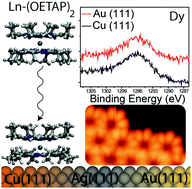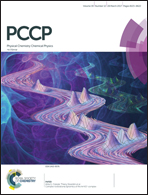Preservation of electronic properties of double-decker complexes on metallic supports†
Abstract
Single-molecule magnets based on lanthanide double-deckers are attracting significant attention due to their unrivaled single-ion anisotropy. To exploit their fascinating electronic and magnetic properties in devices for information storage or spin transport, studies on the preservation or variation of electronic and magnetic functionalities upon adsorption on surfaces are necessary. Herein, we introduced a comprehensive scanning tunneling microscopy (STM) and X-ray photoelectron spectroscopy (XPS) surface science study, complemented by density functional theory (DFT) simulations, of a recently synthesized single-molecule magnet based on porphyrazine deckers, conveniently equipped with ethyl moieties to make them soluble and sublimable. We demonstrated that the double-decker species were intactly adsorbed on Au(111), Ag(111), and Cu(111) in a flat-on fashion and self-assembled in hexagonal close-packed layers. Systematic multi- and monolayer XPS was performed on the surface-confined species, confirming the preservation of the electronic properties of the ligands and the lanthanide center upon adsorption.



 Please wait while we load your content...
Please wait while we load your content...